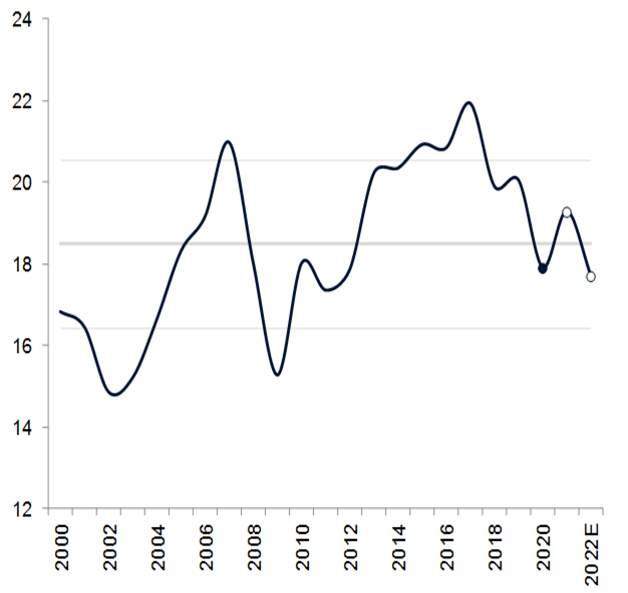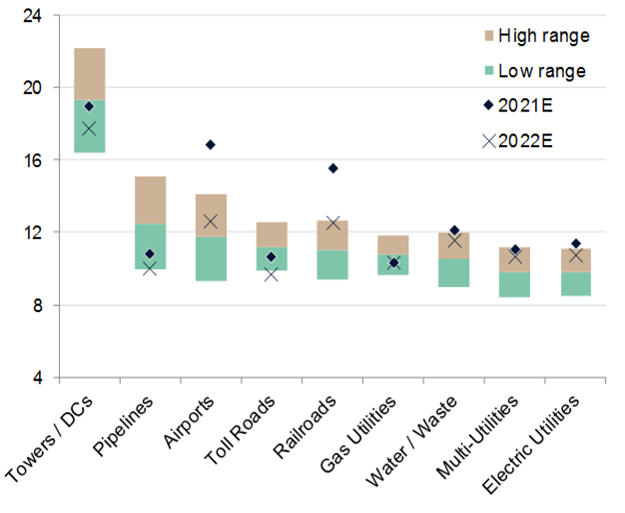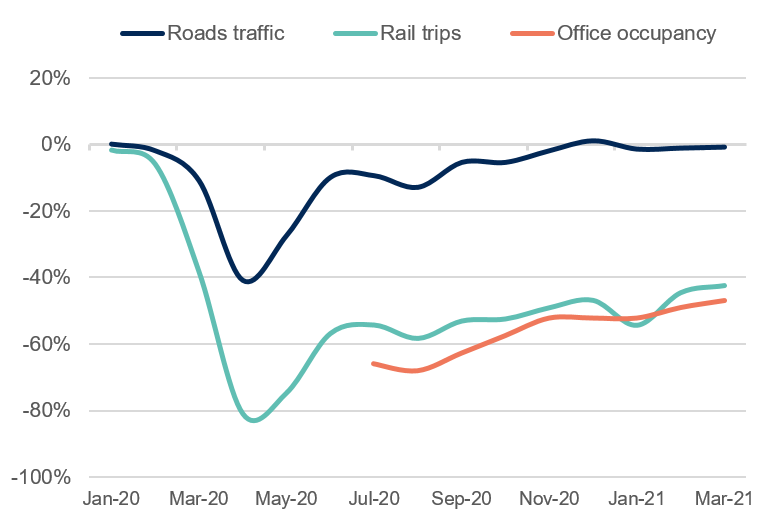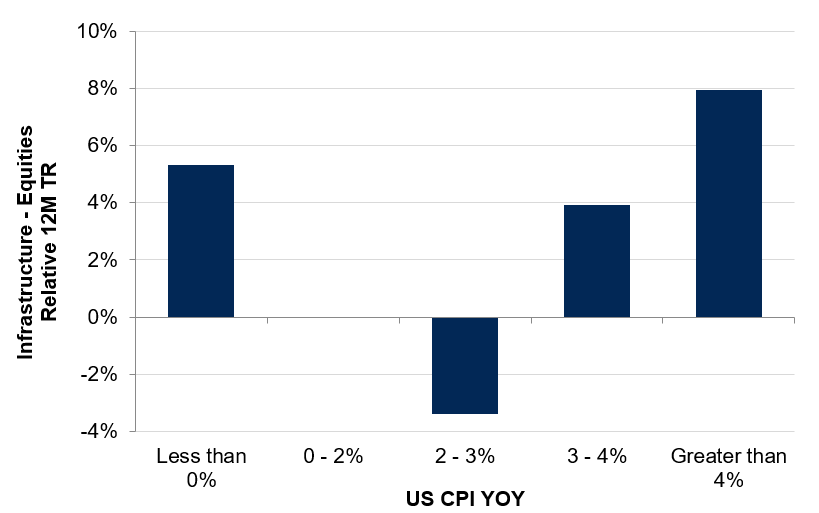Reflation, renewables and the road ahead: 5 infrastructure predictions
As we approach the midpoint of 2021, infrastructure is at an inflection point. Different markets are emerging from COVID-19 at their own pace, while long-term challenges like decarbonisation are more urgent than ever. In a recent client update, our Global Listed Infrastructure team shared their predictions for the sector, summarised in the five points below.
1. The valuation gap is closing
The year 2020 was a particularly challenging year for global listed infrastructure. In fact, if you look over the last 15 years, it was only the second time that the asset class underperformed both global equities and bonds. We believe that a lot of risks, such as rising interest rates, have been priced in. There is now a compelling valuation gap, although we don’t expect it to last.
Valuations are now close to or below their long term historic averages. Balance sheets are in good shape and debt has been locked in at very attractive interest rates. Our view is that the asset class is well positioned to provide investors with income and steady earnings growth for many years to come.
Chart 1: Price/Earnings for Global Infrastructure

Simple average of 250 stocks in universe. Source: Bloomberg, First Sentier Investors, May 2021
Chart 2: Value Range by Sector - EV/EBITDA x

Annual data from 2000 to 2022E. Source: First Sentier Investors, May 2021
2. There is a roadmap for transport recovery
We expect freight rail and toll roads to lead us out of this pandemic, based on global evidence from the second half of 2020. Next on our list would be airports, especially those with large exposures to domestic and leisure travel. When borders open up properly around the world, we can look forward to long haul business travel coming back, as well as a rebound in passenger rail volumes.
Some countries have returned to ‘normal life’ more quickly than others, and data from these regions suggest what the post-vaccine world might look like.
Using Sydney as an example, the data on road volumes, rail passenger numbers and office occupancy rates show that once lockdowns end, toll road volumes quickly rebound.
While the effect of working-from-home (WFH) roughly halved office occupancy, it hasn't materially affected toll roads. This is due to several factors: some occupations simply can’t be done remotely, such as construction; there's been a shift away from rail towards private vehicles, as people avoid crowds; and there's been a modest tailwind from increased e-commerce and online shopping. Overall, toll road volumes have been very resilient in the face of the pandemic.
Chart 3: Toll road volumes

Transurban, Transport NSW, Property Council of Australia and First Sentier Investors. Data as at May 2021
3. There’s no need to fear rising inflation
There's no doubt that low interest rates have been a tailwind for income producing assets like infrastructure. Now expectations have started to shift towards higher interest rates, given the generous stimulus measures and strong economic recovery. It's understandable that investors may see that as a headwind, but in our view, it's important to look at what's really driving that interest rate increase.
If it's being driven by higher inflation, we think infrastructure assets are well positioned.
Most concession agreements are long-term contracts that allow owners to pass inflation through to the end customer. In fact, we estimate that more than 70 per cent of our investable universe has the ability to pass through inflation.
But even in sectors where we don't necessarily have that explicit link – and freight rail is a good example – factors like high barriers to entry give companies good pricing power. In the case of freight rail, we've seen prices increasing on average by around 2-4 per cent per annum .
Chart 4: Infrastructure performance during periods of inflation

4. The Biden Infrastructure Plan is a positive for investors
US President Joe Biden recently announced plans for significant investment in the country’s infrastructure. There’s no doubt this is good news for infrastructure investors.
The plan has a major focus on the decarbonisation of electric utilities, particularly through the 10-year extension of renewable energy tax credits. This is going to provide much-needed, new investment opportunities in wind, solar and batteries.
In comparison to Europe, the US is well behind on its transition to renewables. In 2020, slightly under 40 percent of electricity generated in Europe was from renewables . In the US, that number was just over 20 percent , so it has a lot of catching up to do.
For investors, this means the opportunity is larger, and is one reason we favour US energy investments at the moment.
Biden’s plan has earmarked around US$174b for electric vehicle (EV) infrastructure, creating two opportunities for our investments. Firstly, there will be capital expenditure opportunities to roll out charging stations to remove ‘range anxiety’ (the fear of running out of power); our utilities will be involved in that.
Secondly, in the longer term, EVs are expected to underpin an increase in electricity demand in the late 2020s or early 2030s, as the transition from oil to electricity gathers pace. Looking out to the 2040s, we expect to see an increase in electricity demand of around 20 percent (compared to today), due to EV usage.
Another key pillar of Biden’s plan is the extension of electricity transmission tax credits, worth around US$100 billion. This is because wind and solar energy is mostly produced in the middle of the country, but needs to get to the coastal population centres. These tax credits are designed to incentivise investment in boosting the transmission capabilities required for this transition to renewables.
5. There is a decade-by-decade path to Net Zero Emissions
The first decade is more of what we are already seeing in developed countries: the decarbonisation of the power generation sector. That includes replacing old, inefficient coal plants with renewable energy, and innovations in battery technology that will make renewables competitive with the gas system.
The second decade is about the electrification of transport, which is the largest emitter of carbon in today’s world. Infrastructure providers can achieve this through investment in transmission and distribution assets, pulling energy to centrally located hubs that charging stations can connect to. That will require further investment in renewables, and in transmission and distribution technology.
The 2040s will be focused on tackling those hard-to-abate sectors through step changes in technology. Essentially, we will leave the hardest challenges until last. That includes reducing the cost curves of things like green hydrogen and sustainable aviation fuels. Almost all the strategies to reach net zero require infrastructure investment, so as investors, we have an important role to play in addressing climate change.
Learn more
We invest in shares of infrastructure companies around the world, including operating assets from the transport, utilities, energy and communications sectors. The assets held by these companies typically offer high barriers to entry, pricing power, and structural growth. For further information, please visit our website.
2 topics

